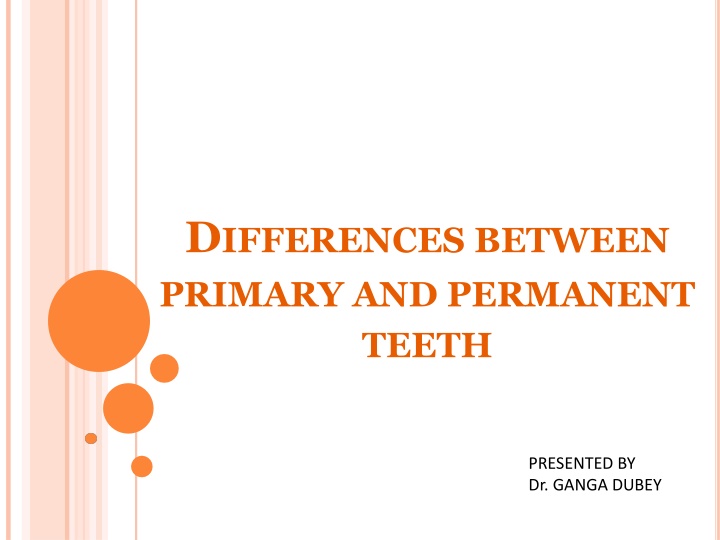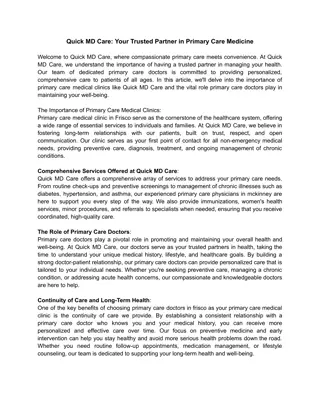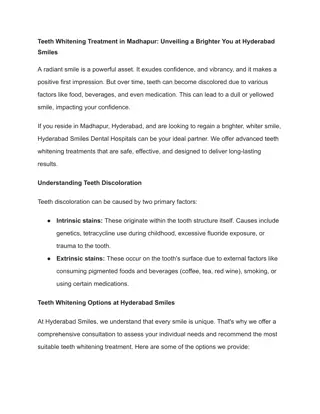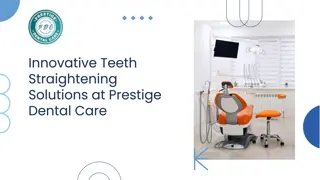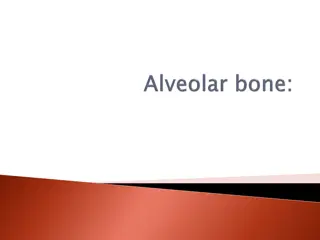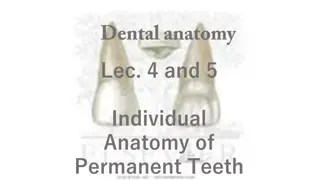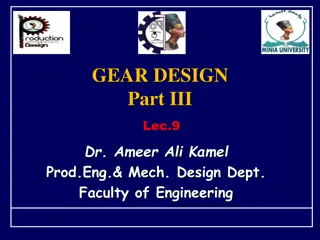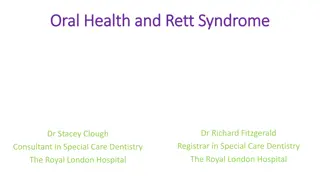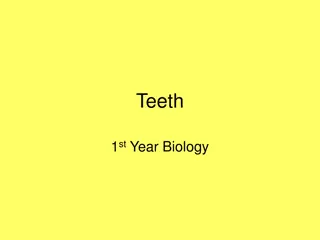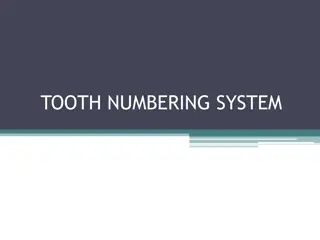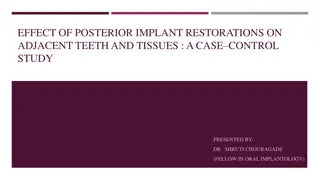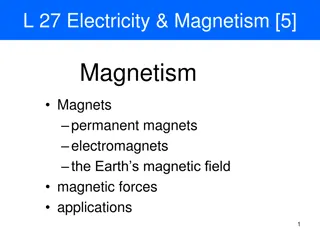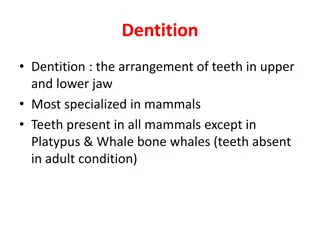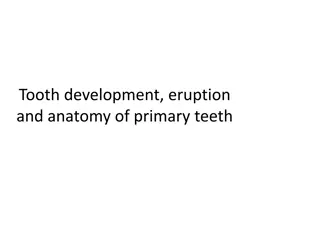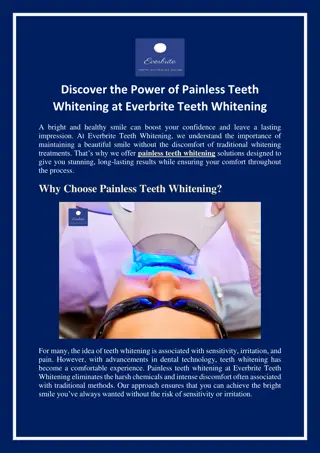Differences Between Primary and Permanent Teeth Explained
Dive into the distinctions between primary (baby) and permanent teeth presented by Dr. Ganga Dubey. Explore general variances, eruption sequences, crown characteristics, and histological differences. Understand individual variations in tooth morphology for a comprehensive comparison.
Download Presentation

Please find below an Image/Link to download the presentation.
The content on the website is provided AS IS for your information and personal use only. It may not be sold, licensed, or shared on other websites without obtaining consent from the author.If you encounter any issues during the download, it is possible that the publisher has removed the file from their server.
You are allowed to download the files provided on this website for personal or commercial use, subject to the condition that they are used lawfully. All files are the property of their respective owners.
The content on the website is provided AS IS for your information and personal use only. It may not be sold, licensed, or shared on other websites without obtaining consent from the author.
E N D
Presentation Transcript
DIFFERENCES BETWEEN PRIMARY AND PERMANENT TEETH PRESENTED BY Dr. GANGA DUBEY
CONTENTS Introduction General differences Eruption sequences Crown Pulp Root Enamel Dentin Periodontium Histological differences Individual differences in morphology of tooth
INTRODUCTION Primary teeth are also called as temporary , milk , deciduous or baby teeth. They are present from infancy stage till early teenage. Though they are erroneously considered as a annoyance , they play a major role in mastication and maintaining space for eruption of permanent teeth. Significant differences in different aspects distinguish them from their permanent counterparts.
GENERAL DIFFERENCES No. of teeth present:-primary-20 permanent 28-32 Teeth formula:- ICPM/ICPM primary- 2102/2102 permanent- 2123/2123 Bicuspids and third molars are absent in the primary setof tooth. Primary teeth are smaller in size when compare to permanent teeth. 1st tooth to erupt into the oral cavity is mandibular incisor whereas in permanent teeth it is the mandibular firstmolar. Primate space is absent in primaryteeth. Primary teeth are present within the age of 6 months-10 to 12 years ( @ the age of 13 years only about 5% of primary teeth remains).
Eruption sequence follows a pattern incisors-first molars- canines-second molars. This pattern is generally followed by both arches, with the mandibular arch preceding the maxillary arch. The loss of deciduous teeth tends to mirror the eruption sequence. Caries susceptibility is reverse of this order.
CROWN PRIMARYTEETH PERMANENT TEETH Bluish white in color. Refractive index similar to that of milk( RI=1). smaller in all dimensions . Exposed area is about one-half that of the permanent teeth. Grayish white to yellowish white in color. Larger in dimensions. Larger in cervico-occlusal dimension than the mesio- distal dimension. this gives a longer appearance to permanent anterior teeth. Wider mesio-distally in relation to cervico-occlusal dimension. this gives a cup shaped appearance to the anterior teeth and squat shaped appearance to the molars.
PERMANENT TEETH PRIMARYTEETH Cuspids are slender and to be more conical. Cuspids are less conical. The cervical ridges are flatter. Cervical ridges are more pronounced especially on buccal aspect of first primary molar. There is less convergence of buccal and lingual surface of molars towards occlusal surface. Buccal and lingual surface of molars , especially 1st molar, converge towards occlusal surface so they have a narrow occlusal table in the bucco- lingual plane.
PERMANENT TEETH PRIMARYTEETH Occlusal plane is relatively flat. Occlusal plane has relatively curved contour. Molars are bulbous and are sharply constricted cervically. They have less constriction at the neck. The contact areas between molars are broader , flatter and situated gingivally. The contact point between permanent molars is situated occlusally.
PERMANENT TEETH PRIMARYTEETH Supplemental grooves are more. Supplemental grooves are less. Mammelons are absent. Mammelons are present on incisal edges of newly erupted incisors. 1st molar is smaller in dimension than the 2ndmolar 1st molar is larger in dimension than the 2ndmolar.
PULP (PULP CHAMBER ANATOMY IN BOTH PRIMARY AND PERMANENT TEETH CLOSELY APPROXIMATES THE SURFACE SHAPE OF THE CROWN) PRIMARY TEETH PERMANENT TEETH Pulp chamber is larger in relation to crown size. Pulp chamber is smaller in relation to crown size. Pulpal outline follows DEJ more closely. Pulpal outline follows DEJ less closely. Pulp horns are closer to the outer surface. Mesial pulp horn extends to a closer approximation of surface than the distal pulp horn. The pulp horns are comparatively away from the outer surface. Comparatively less degree of cellularity and vascularity in tissue. High degree of cellularity and vascularity in tissue. Comparatively less potential for repair. High potential for repair.
PERMANENT TEETH PRIMARYTEETH Comparatively less tooth structure. More tooth structure protecting the pulp. Greater thickness of dentin over occlusal fossa of molars. Comparatively lesser thickness of dentin over the pulpal wall at the occlusal fossa of molars. Root canals are more ribbon like. the radicular pulp follows a thin , tortuous and branching path. Root canals are well defined with less branching. Floor of pulp chamber does not have any accessory canal. Floor of pulp chamber is porous. Accessory canals in primary pulp chamber floor leads directly into inter- radicular furcation.
ROOT PRIMARYTEETH PERMANENT TEETH Roots are larger and more slender in comparison to crown size. Furcation is more towards cervical area so that root trunk is smaller . Roots are narrower mesio-distally. At the cervical region, the roots of the primary molars flare outward and continue to flare as they approach the apices to accommodate permanent tooth buds. Undergo physiologic resorption during shedding of primary teeth. Roots are shorter and bulbous in comparison to crown. Placement of furcation is apical , thus the root trunk is larger. Roots are broader mesio- distally. Marked flaring of roots is absent. Physiologic resorption is absent.
ENAMEL Bands of retzius are less common. This maybe partly responsible for the bluish white color. PRIMARYTEETH PERMANENT TEETH Bands of retzius are more common. Neonatal lines are only present in 1stmolars Neonatal lines are present in all teeth. The enamel is thicker and has a thickness of about 2-3mm. Enamel rods are oriented gingivally. Enamel is thinner and has a more consistent depth of about 1mm thickness throughout the entire crown
DENTIN PRIMARYTEETH PERMANENT TEETH Dentinal tubules are less regular. Dentinal tubules are more regular. Dentin thickness is half that of permanent teeth. Thickness is limited in some places. Den. Dentin is thicker. Dentin is denser and difficult to cut. Less dense and easy to cut. Interglobular dentin is absent. Interglobular dentin is present.
PERIODONTIUM PRIMARYTEETH PERMANENT TEETH Cementum is very thin and o the primary type. Secondary cementum is characteristically absent. Secondary cementum is present. Alveolar atrophy occurs. Gingivitis is common in adults. Alveolar atrophy is rare. Gingivitis is generally absent in a healthy child. Similarly recession is in frequent.
HISTOLOGICAL DIFFERENCES PRIMARY TEETH PERMANENT TEETH Roots have enlarged apical foramens. Thus , the abundant blood supply demonstrates a more typical inflammatory response. Foramens are restricted. Thus reduced blood supply favors a calcific response and healing by calcific scarring. Reparative dentin formation is less. Incidence of reparative dentin formation beneath carious lesion is more extensive and irregular. Pulp nerve fibres terminate mainly among the odontoblasts and even beyond the predentin. Pulp nerve fibers pass to the odontoblastic area, where they terminate as free nerve endings.
PERMANENT TEETH PRIMARYTEETH Density of innervations is less because of which primary teeth are less susceptible to operative procedures. Neural tissue is the first to degenerate when root resorption takes place. Density of innervations is more. Infection and inflammation in pulp is localized . Localization of infection and inflammation is poorer in pulp
INDIVIDUAL DIFFERENCES IN TOOTH MORPHOLOGY
MAXILLARY CENTRAL INCISOR Mesio-distal measurement is greater than cervico-incisal measurement. Labial surface is slightly convex with little evidence of developmental grooves. The incisal edge joins the mesial surface at an acute angle and the distal surface at a more obtuse angle.
MAXILLARY LATERAL INCISOR Smaller in most dimensions. Disto-incisal angle is more rounded. Lingual anatomy is less prominent. Root is longer in proportion to the crown.
MAXILLARY CANINE Larger than incisors in all dimensions. All crown surfaces the are convex creating a more pronounced constriction at the cervix prominent cusp. Lingual surface presents a lingual ridge , fossa and marginal ridges. The root is long and tapered toward the apex, and shows increase in diameter just apical to the cervical line.
MANDIBULAR CENTRAL INCISOR Smaller in all dimensions than MCI. Labially appears symmetric, less convex and smooth without evidence of developmental grooves. Lingual surface is usually smooth with poorly defined fossa and marginal ridges. Root is long and evenly tapered toward the apex.
MANDIBULAR LATERAL INCISORS Similar in morphology to that of CI, except that the incisal edge slopes downward distallly forming a more obtuse disto-incisal angle. Slightly larger cervico- incisally and mesiodistally than CI. Root is conical, longer than that of CI and shows definite inclination at the apex. Distal surface of the root will show a longitudinal depression or groove separating labial and lingual surfaces.
MANDIBULAR CANINE Appears more slender than MC because of smaller mesio-distal diameter in relation to crown height The disto-incisal edge is longer. Marginal ridges and cingulum are less prominent. Labio-lingual diameter is smaller than MC. Root is smoothly tapered from the cervical line to the apex.
MAXILLARY FIRST MOLAR Appears triangular when viewed occlusally. Proximal surfaces converge lingually creating a crown that is wider mesio- distally at the bucal surface. Mesio-lingual cusp is the largest followed by mesio-buccal and disto- buccal. Mesially , prominent bucco-cervical ridge can be seen 3 long and slender roots are present. Lingual root is the longest All three roots extend from a shortroot base in a divergent manner.
MAXILLARY SECOND MOLAR Similar to maxillary 1st permanent premolar (crown form, pit , groove and cusp arrangement. Four cusps. Largest is mesiolingual . Distobuccal is the smallest and other 2 are almost of the same size. Occlusal surface 3 pits which meet at the intersection of the developmental groove 3 roots. Lingual root is the largest and distobuccal is the smallest. Root morphology is similar to that of to that of 1stpermanent molar except that roots are flared and diverge more from the root base.
MANDIBULAR 1STMOLAR When viewed from occlusal aspect the outline is rhomboidal in shape. 2 buccal cusps and 1 lingual cusp. 3 pits are found on occlusal surface of which the surface-central is most prominent. A distinguishing feature is heavy transverse ridge connecting the mesio- buccal and mesio-lingual cusps. 2 roots ; mesial and distal. They show typical flaring and end in a sharp edge which may be slightly bifid The most unique feature of this tooth is that is does not resemble any tooth in the permanent set.
MANDIBULAR 2NDMOLAR Smaller replica of the mandibular 1st permanent molar. 3 buccal cusps distobuccal(largest),followed by the mesio-buccal and the distal. 2 lingual cups which are similar in size. 3 pits ; central(prominent) ,mesial, distal. Crown morphology shows typical cervical constriction and bucco- cervical ridge as seen of other primary molars. 2 roots ;mesial and distal. Narrow mesiodistally and broad buccolingually. Roots are more diverged than 1stmolar
MORPHOLOGIC CONSIDERATIONS Crowns are smaller and more bulbous than their permanent counterparts, and the molars are bell shaped with a definite constriction in the cervical region The characteristic sharp lingual inclination occlusally of the facial surfaces results in the formation of distinct faciogingival that ends abruptly at the CEJ. The sharp constriction at the neck of the primary molar necessitates special care in the formation of the gingival floor during class2 tooth preparation . The buccal and lingual surfaces of the molars converging sharply occlusally results in a narrow occlusal surface or food table.
The pulpal outline follows the DEJ more closely than that of the permanent teeth. The pulpal horns are longer and more pointed than the cusps would indicate. The dentin also has less bulk or thickness, and so the pulp is proportionately larger than that of the permanent teeth . The enamel of primary teeth is thin but of uniform thickness . The enamel surface tends to be parallel to the DEJ.
